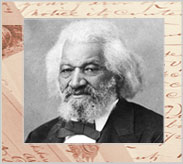 |
|
 |
| Step 1: A Biographical Sketch of
Frederick Douglass |
Next |
 One
of our first books was a biography of Frederick Douglass, a well-known
abolitionist. Our first draft wasn't very good because we were simply
listing facts instead of telling a story. And who wants to read
a bunch of dull facts? Here is an example from our first draft: One
of our first books was a biography of Frederick Douglass, a well-known
abolitionist. Our first draft wasn't very good because we were simply
listing facts instead of telling a story. And who wants to read
a bunch of dull facts? Here is an example from our first draft:
First Draft
Frederick Douglass
was born a slave in Maryland in February 1817. His slave master's
wife, Mrs. Sophia Auld, taught him how to read. Once he could read,
Frederick was determined to be free. His master hired him out to
work on ships in Baltimore's large shipping industry. Frederick
worked all week, but his pay went to his master. Frederick used
a sailor's protection papers to escape to New York. Once free, Frederick
became an abolitionist who spoke out against slavery. He wrote his
autobiography and edited The North Star, an abolitionist
newspaper. He died in 1895.
Then we got smart! Instead of trying to cram in all the facts,
we chose one very important story from Douglass's life ("Frederick
used a sailor's protection papers to escape to New York").
Using the colorful details and data we found through our research,
we developed a much more interesting biographical sketch. The story
served as a hook for our facts. Take a look at our final draft below.
Final Draft
In 1838, the
primary political issue in Baltimore, Maryland, was slavery. Frederick
Douglass was a slave in Baltimore, but he was determined not to
stay one. It was just a matter of time before he would escape.
Frederick's
master, Hugh Auld, hired him out as a ship caulker. One day at lunch,
Frederick met Benny — a black sailor whose ship had sailed
without him. Benny decided to stay in Baltimore. Frederick helped
him get a job in the shipyard, and the two young men became friends.
Benny introduced Frederick to fellow members of the East Baltimore
Mental Improvement Society. Most of these young men and women were
free blacks who could read and write. Although his master's wife,
Mrs. Sophia Auld, had taught Frederick to read and write when he
was very young, he felt self-conscious because he was a slave. But
his new friends didn't seem to mind that he was a slave — especially
Anna Murray.
Frederick and
Anna fell in love. But he wouldn't marry her until he was free.
On September 2, 1838, Frederick put his escape plan into action.
He dressed in Benny's sailor suit. Then, using Benny's sailor's
protection papers, Frederick boarded the train and bought a ticket.
If the conductor had examined the papers closer, he would have realized
that the person it described looked nothing like Frederick.
The train sped
through Maryland, then crossed into Delaware, which was still a
slave state. Frederick had to be very careful. He kept telling himself
to stay calm and not look worried or frightened. In Wilmington,
Delaware, Frederick took a steamship up the Delaware River to Philadelphia.
Again, the borrowed papers were not closely inspected! From Philadelphia,
Frederick took another train and arrived in New York on Tuesday,
September 4, 1838. Freedom!
The first thing
Frederick did was send an important message to Anna Murray. Just
as she had promised, she rushed to New York, where she and Frederick
were married immediately.
Frederick Douglass
could have lived a quiet, peaceful life in freedom, but instead
he chose to take a stand against slavery. Pro-slavery supporters
accused Douglass of being a fraud because he was "too literate,"
and "too articulate." To prove that he had been a slave,
Douglass wrote his autobiography, The Life and Times of Frederick
Douglass, giving names, dates, and places. He also started an
abolitionist newspaper, The North Star, which was a symbol
for all runaways. Frederick Douglass died in 1895 after spending
a lifetime fighting for the complete abolition of slavery, equal
rights for women, and justice for all.
|
 |
 |